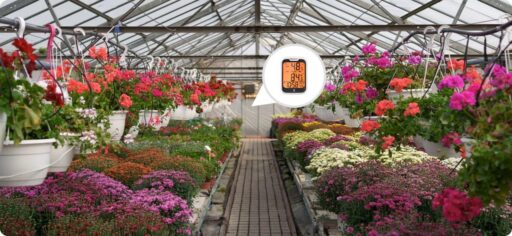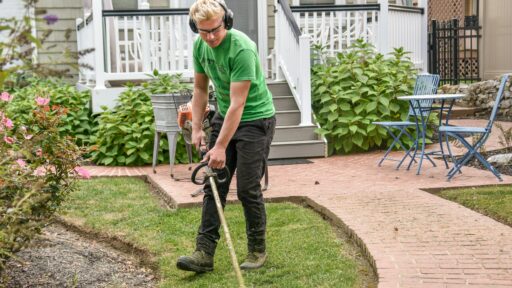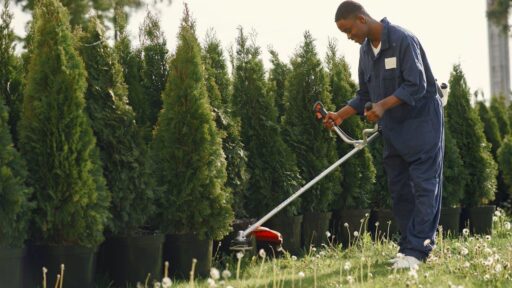The first blush of pink on your heirloom tomato. The triumphant spike of an orchid finally ready to bloom. The crisp perfection of a cucumber grown with your own hands. This is the dream that draws us to greenhouse gardening. It’s a sanctuary, a place where we bend nature to our will to create a paradise of growth.
But any seasoned gardener knows the greenhouse dream can quickly become a nightmare. The leaves of your prized Monstera develop unsightly brown, crispy edges. Your seedling trays seem to be blanketed in a sinister gray fuzz overnight. Despite your careful watering, plants look wilted and sad.
If this sounds familiar, you’re not failing. You’re just flying blind. The invisible force you’re battling isn’t your skill—it’s your greenhouse’s microclimate. The secret to taming it? Understanding the humidity.
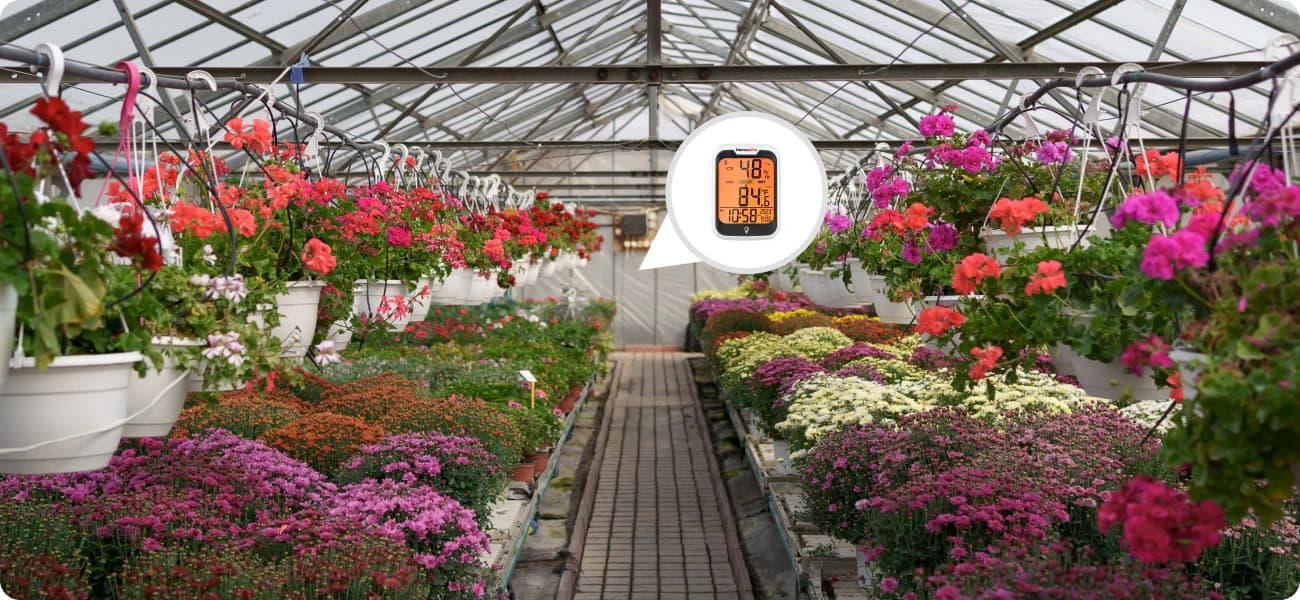
Why Temperature and Humidity Matter in Greenhouses
A greenhouse provides a controlled environment, shielding plants from harsh outdoor conditions. But “controlled” doesn’t mean perfect—temperature swings and fluctuating humidity levels are more common than many beginners realize.
Temperature: Most greenhouse plants prefer daytime temperatures between 70–80°F (21–27°C) and cooler nights around 60–65°F (15–18°C). Too hot, and plants may become stressed and stop growing. Too cold, and growth slows to a crawl.
Plants don’t just drink through their roots; they breathe through their leaves. This process, called transpiration, is the engine of plant growth. It’s directly controlled by the humidity and temperature in the surrounding air.
Get it right, and you create a growth accelerator. Get it wrong, and you invite disease, stress, and failure.
Too Humid (High Humidity): When the air is saturated with moisture, plant transpiration slams on the brakes. Water and nutrients can’t move efficiently through the plant. This stagnant, muggy air is the perfect breeding ground for powdery mildew, botrytis (gray mold), and fungal root rot. Your greenhouse becomes a petri dish instead of a paradise.
Too Dry (Low Humidity): In arid conditions, plants transpire too quickly, desperately losing moisture to the dry air. Even if their roots are wet, they can’t pull up water fast enough to keep up, leading to crispy leaf edges, stunted growth, and flower drop. Your plants are essentially in a state of constant drought stress.
The goal isn’t a single “perfect” number. It’s about providing the right range for your specific plants and maintaining stability. Seedlings and tropical plants often thrive in 70-90% RH, while mature tomatoes and succulents prefer a lower 40-70% range. The only way to know what’s happening in your greenhouse is to measure it.
The Struggles Greenhouse Gardeners Face
Many greenhouse owners share the same frustrations:
- Unseen problems: By the time you notice curling leaves or slowed growth, environmental stress has already set in.
- Guesswork: Relying on “gut feeling” to judge humidity or temperature often leads to inconsistent plant health.
- Seasonal extremes: Hot summers or dry winters make it even harder to keep conditions stable.
These challenges highlight why a reliable humidity and temperature monitoring system is no longer a luxury but a necessity.
Why Gardeners Need a Wireless Indoor Hygrometer Thermometer
Imagine walking into your greenhouse early in the morning. The air feels damp, but is it enough for your tropical ferns? Your tomatoes look fine today, but are the nights too cold for their roots? Instead of guessing, a hygrometer thermometer provides clear answers.
A wireless indoor hygrometer thermometer offers:
- Real-time monitoring: Know the exact temperature and humidity at any moment.
- Historical data tracking: Spot patterns—like whether humidity drops too low overnight—that help you make adjustments before issues appear.
- Peace of mind: You’ll know your plants are growing in the best possible conditions without second-guessing.
Creating the Ideal Greenhouse Environment
With reliable data, gardeners can adjust their environment with precision. A few small tweaks can dramatically improve plant health:
- Ventilation: Open vents or install fans when temperatures rise too high.
- Misting systems: Increase humidity for tropical plants during dry spells.
- Shade cloths: Protect sensitive plants from intense summer sun.
- Heaters: Keep the greenhouse warm on chilly nights, especially for young seedlings.
The key is consistency—and a hygrometer thermometer ensures you’re always one step ahead.
Why the ThermoPro TP358 is Perfect for Greenhouse Gardening
Among the many options available, the ThermoPro TP358 Bluetooth Indoor Hygrometer Thermometer stands out for greenhouse enthusiasts. Here’s why:
- Accurate readings: With precise sensors, it quickly picks up even small shifts in temperature and humidity.
- 260-ft Bluetooth connectivity: Syncs easily with your smartphone, so you can check greenhouse conditions without stepping inside.
- Data graphs and trends: Its smart app lets you analyze hourly to yearly trends and export up to 2 years of data, helping you see long-term patterns that affect plant growth.
- User-friendly design: The large backlit display is easy to read at a glance, even in dim greenhouse lighting.
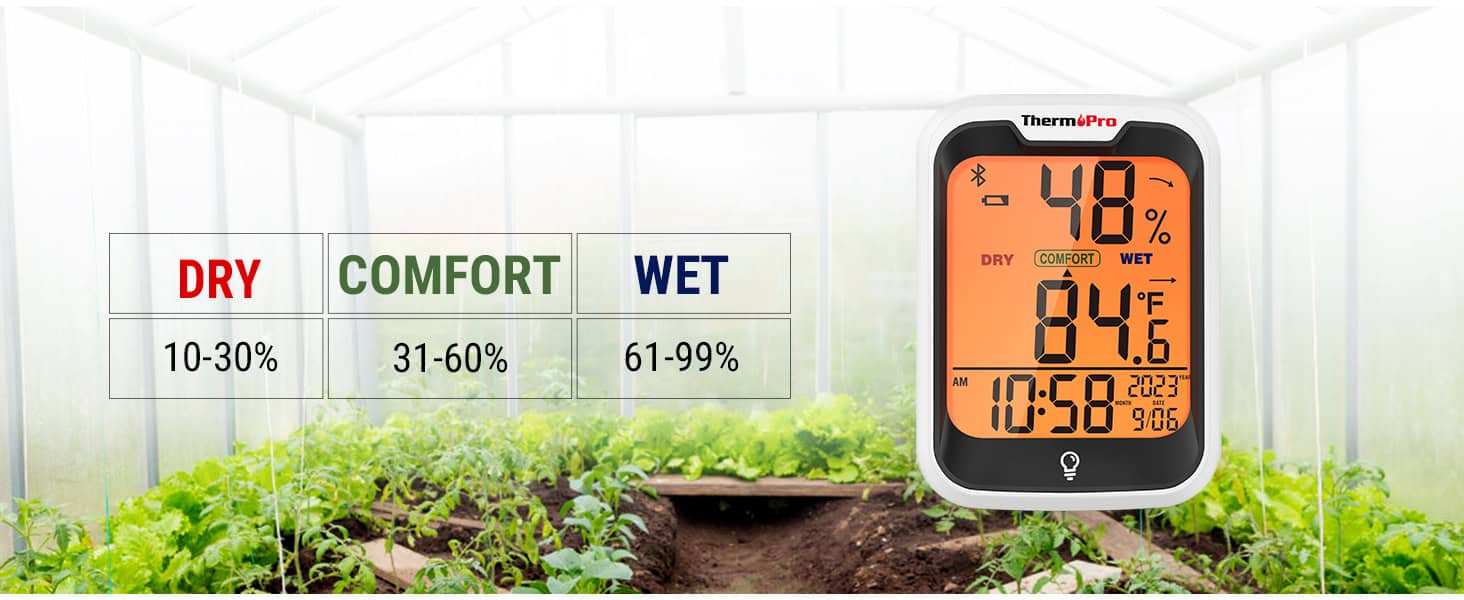
For gardeners who are serious about protecting their investment—whether it’s exotic orchids, juicy tomatoes, or a flourishing herb garden—the ThermoPro TP358 takes the guesswork out of greenhouse care.
Final Thoughts
For greenhouse enthusiasts in the U.S., maintaining the right balance of temperature and humidity is the foundation of plant health. ThermoPro TP358 Bluetooth Indoor Hygrometer Thermometer provides the clarity and control needed to create the perfect environment. By tracking conditions in real time and offering actionable insights, it helps gardeners protect their plants, improve growth, and enjoy the true rewards of greenhouse gardening.
If your goal is vibrant, healthy, and resilient plants, it all starts with understanding your environment—and the right hygrometer makes that possible.

